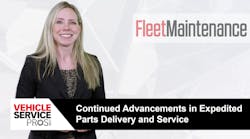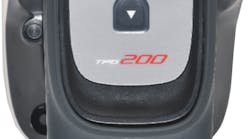Tires are the second highest expense for fleets, behind fuel. Over- and under-inflated tires can significantly reduce the life of a tire. Scot Holloway, CEO of Bartec USA, talks about the challenges fleets face when it comes to monitoring tire pressure and measuring tread life, and trends in tools and technology for monitoring commercial vehicle tires.
Transcription of interview:
Erica Schueller, Fleet Maintenance: Hello and welcome to another episode of VSP News: Uptime Update. I am your host Erica Schueller, Editor-in-Chief of Fleet Maintenance magazine, covering all maintenance, all vehicle classes, all management, all the time.
Tires are the second highest expense for fleets, behind fuel. Over- and under-inflated tires can significantly reduce the life of a tire. This can happen by causing uneven tread wear, increasing the potential for punctures, and generating excessive heat which may lead to thermal events. It makes sense then that fleets tend to focus on any available resources and preventive measures to monitor and manage tires.
I spoke with Scot Holloway, CEO of Bartec USA about the challenges fleets face when it comes to monitoring tire pressure and measuring tread life on commercial vehicle tires. He first shared details about the importance of why fleets should prioritize tire monitoring.
Scot Holloway, Bartec USA: It’s about safety, compliance and economics. Properly inflated tires that have the proper amount of remaining tread life are safe, provide the best performance, and give the best return on investment for the fleet.
Under-inflated tires that are low on tire tread don’t perform well, cost fuel, and are not safe.
Schueller, Fleet Maintenance: Holloway talks about the requirements for tire measurement and inspection, along with the current options available to technicians for measuring and inspecting pressure and tread depth.
Holloway, Bartec: Acceptable remaining tread is 4/32nds of an inch on axles that steer, and 2/32nds of an inch on all other tires on a commercial vehicle. Currently there are really three ways to check the remaining tire tread – some are high-tech, and some are not:
- Tread depth gauge. Traditionally you can manually measure each tire with a tread depth stick gauge, and record that on paper or a tablet inspection app.
- Drive-over tread depth measuring equipment. On the other end of the spectrum is emerging drive-over technology, where laser measuring equipment can measure the remaining tire tread.
- Handheld tread depth measuring tool. What Bartec specializes in is the third option: handheld equipment which can measure remaining tread life with a handheld device very accurately, in any way that makes particular sense for the user.
Schueller, Fleet Maintenance: There have been advancements in tool and equipment technology to more efficiently and accurately monitor and maintain tires in the shop. Holloway shares more.
Holloway, Bartec: It’s all about technology. At the high end of the technology spectrum are the drive-over laser measurement equipment. This equipment is largely hands-off, but it’s kind of rigid in the way it can be used within a process.
Alternatively there are hand-held devices where you can literally measure tread depth and tire pressure anywhere you want – whether that’s during a pre-trip inspection or part of a preventive maintenance program, where you walk around the vehicle, the trailer or the tractor, and measure remaining tread life and pressure.
The other part of that whole equation is, what do you do with all that information?
As I said, it’s all about technology, and having the ability to record that information easily from a device onto a tablet app and to store that information in a cloud-based application makes that information easily retrievable , makes proving your compliant a lot easier, and makes it more economical to complete these inspections.
Schueller, Fleet Maintenance: Data collection and analysis continue to drive efficiency in shops, and tire monitoring is no exception. Holloway talks more about trends with the latest tire monitoring products available.
Holloway, Bartec: With everything, it seems it’s in the cloud. It’s web-based, database applications where you’re connecting the physical point of where the measurement or the data is being collected through a device – whether it’s a tablet or something connected to the internet – to a database that exists in the cloud, where that information can be retrieved locally in a service yard where they maintain the vehicles, or at a corporate level where they have to prove compliance and send data long to regulatory agencies.
All that data is handled in the cloud, in a database.
Schueller, Fleet Maintenance: If you’d like more information on the tire pressure and tread depth measuring tools, check the link below.
That’s it for this week’s episode! Thank you for tuning in to VSP News Uptime Update, I’m your host Erica Schueller.
Until our next broadcast, keep up with this, and other industry topics, by visiting us online at VehicleServicePros.com.
Find more information on tire pressure and tread depth measuring tools.


